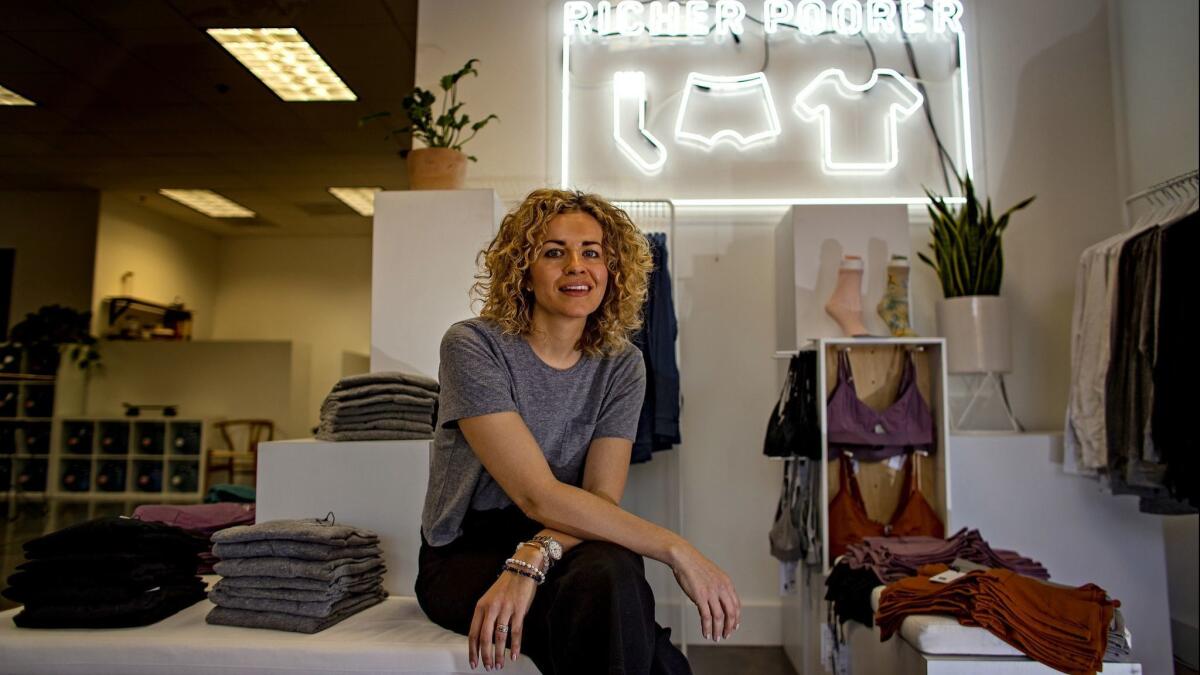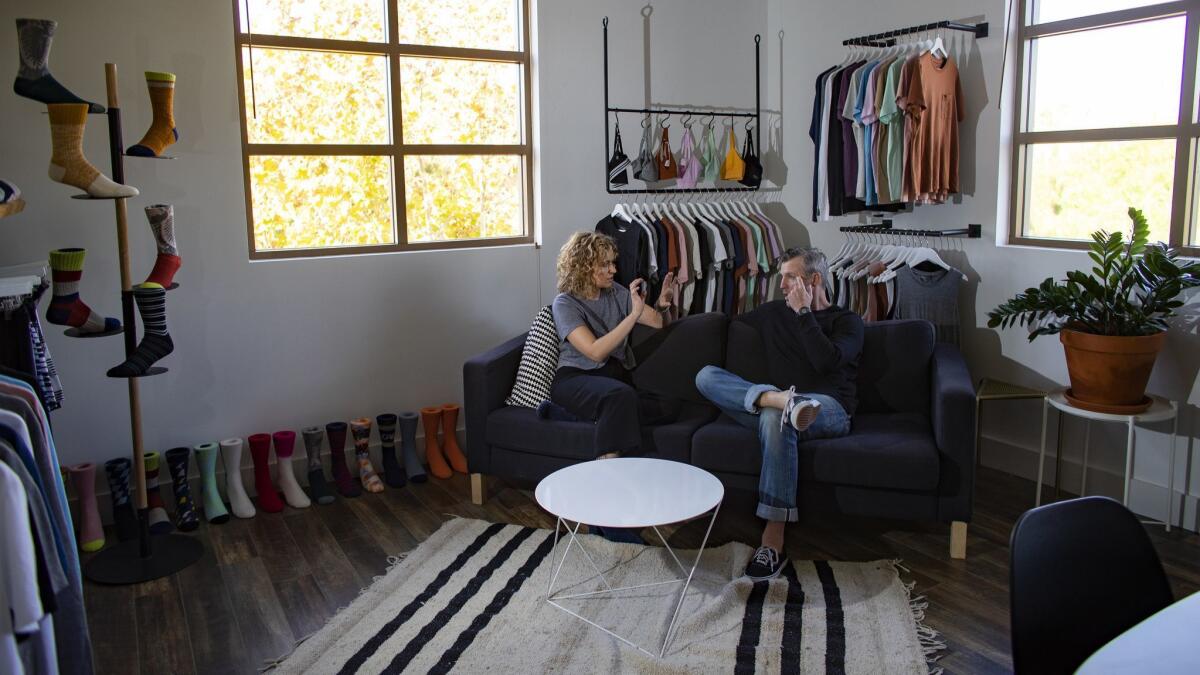How I Made It: This entrepreneur went from rags to socks and underwear riches

- Share via
Iva Pawling, 36, is chief executive of Richer Poorer, a San Juan Capistrano apparel company founded in 2010. Richer Poorer’s T-shirts, bralettes, socks and sweats are sold at more than 900 retailers around the world. Pawling and co-founder Tim Morse have owned the company twice, having sold it and then bought it back to rescue it from bankruptcy. The company has 36 employees and is expecting a record $10 million in revenue for 2018.
Early fashionista
Pawling and her older sister, Gorjana, were keenly interested in fashion while growing up in Scottsdale, Ariz., but opportunities for filling their closets were few. “We were always obsessed with brands and clothing, but it was this thing that we could not attain,” Pawling said. “My parents were typical immigrants. It was, just hoard your money. You don’t spend it on things like that.”
In spades
After graduating with a degree in communications from Arizona State University, Pawling used what she learned to land her dream job in New York with fashion designer Kate Spade, ending up in the public relations department. It gave her a crash course in the industry. “You would start as a part-time receptionist for half the day,” Pawling said. “The other half of the day, you would bounce around from department to department so that you could really understand the full scope of how a fashion brand works.”
Strong women
Pawling later worked in public relations for Bennet Group Strategic Communications in Hawaii, having followed her husband, Andrew, there during his military career. Again, she worked primarily on fashion. Then her sister had started her own eponymous jewelry brand, and Pawling went to work for her. “I think working for Kate, Joan Bennet, who ran the Hawaii firm, and my sister very much contributed to the belief that I could do it, too.”

Spinning an idea
Inspiration to start a business can come from unusual sources, like from your indoor cycling instructor. Tim Morse, the teacher, turned into a business partner, starting with socks.
“Everyone started dressing down. Nobody was wearing ties anymore, and socks were a great way to kind of differentiate,” Pawling said. “Our belief was that this could be a great business model and nobody had seen it yet — or this was a terrible business model and there’s a reason nobody’s doing this.”
The scramble
Neither partner had a background in making apparel, so there was a learning curve. “One of my neighbors ran production for a brand, and I asked him if he had any sock manufacturers and he did,” Pawling said. “There was a gentleman at a community college in North Carolina who trained people how to manufacture socks. He spent hours talking with me.”
Those conversations began in May 2010, and the business had products in stores by December, but not without problems. The first socks were so tight that people couldn’t get them on their feet. Initial packaging was also a problem.
“We tried to create this box that ended up getting destroyed when it was being put back on and off the rack in store,” Pawling said. “And when you don’t have high sell-through, like at one retailer, they don’t work with you for a long period of time. It’s like ‘We tested you, it didn’t work, we’re moving on.’ ”
The partnership
With better manufacturing and revamped packaging, Richer Poorer improved to $1 million in sales in its third year of operations, compared with just $270,000 in its first full year. The partners added products, and socks are now less than 50% of sales. The partnership with Morse, whose title is president, was a big factor, Pawling said.
“Every new product that we’ve introduced, even bralettes, have been his idea,” she said. “He is the one that’s constantly seeing things in the market and saying ‘We should run in that direction.’ ”
“I am much more operational. I like the blocking and tackling, the process side of the business,” Pawling said.
Failed strategy
In 2015, believing that the company needed a strategic partner to move to the next level, Richer Poorer was sold to Shoes.com for $12 million in cash and stock. Pawling and Morse stayed on after the acquisition. But soon the two discovered that Shoes.com was hemorrhaging and laying off workers.
“They were supposed to take on all of our back-end operations and take over the e-com operations and help run that,” Pawling said. “They didn’t touch anything. It was a disaster.”

Owners again
In December 2016, Pawling and Morse got help from investors to buy back the company for $8 million, shortly before Shoes.com filed for bankruptcy protection, which wiped out the value of the stock the duo had received. By June 2018, Pawling and Morse were able to buy out their investors and were back to being sole owners of the company. The evolution has been more difficult than it looked.
“Externally, you can look at things and go, ‘Wow. The business is growing. Things are great,’ ” Pawling said. “Internally, you’re trying to figure out how to manage cash flow and manage a team and people leave and you hire new ones. Those things are really, really hard to do.”
Advice
“I tell every single person that is starting a brand and trying to get into the majors, wait at least a few seasons,” Pawling said. “Work all those kinks out. Make sure that everything is not only functioning properly from a production standpoint but also that your packaging works in the retail environment.”
Stagnation has to be avoided at all costs, Pawling said.
“If you’re looking back six months and you’re still doing every single thing you were doing six months ago, exactly the same, you’re not growing enough.”
Leadership style
“I don’t micromanage. I give everybody the guardrails,” she said, and then lets them find their own way. “I want them to make mistakes. If they’re not making mistakes, in my mind, and if we’re not making mistakes as a brand and as an organization, we’re not trying hard enough to do things differently.”
Personal
Pawling has been married to her husband, Andrew, for 15 years. They started dating at 14. They have a 5-year- old son and a 6-month-old daughter. “We go to parks, go to the beach. For my own personal sanity, I work out a lot,” Pawling said. Her husband works in food manufacturing. “He makes sauces and I made socks, which my son has always found really amusing to say,” Pawling said.
More to Read
Inside the business of entertainment
The Wide Shot brings you news, analysis and insights on everything from streaming wars to production — and what it all means for the future.
You may occasionally receive promotional content from the Los Angeles Times.











